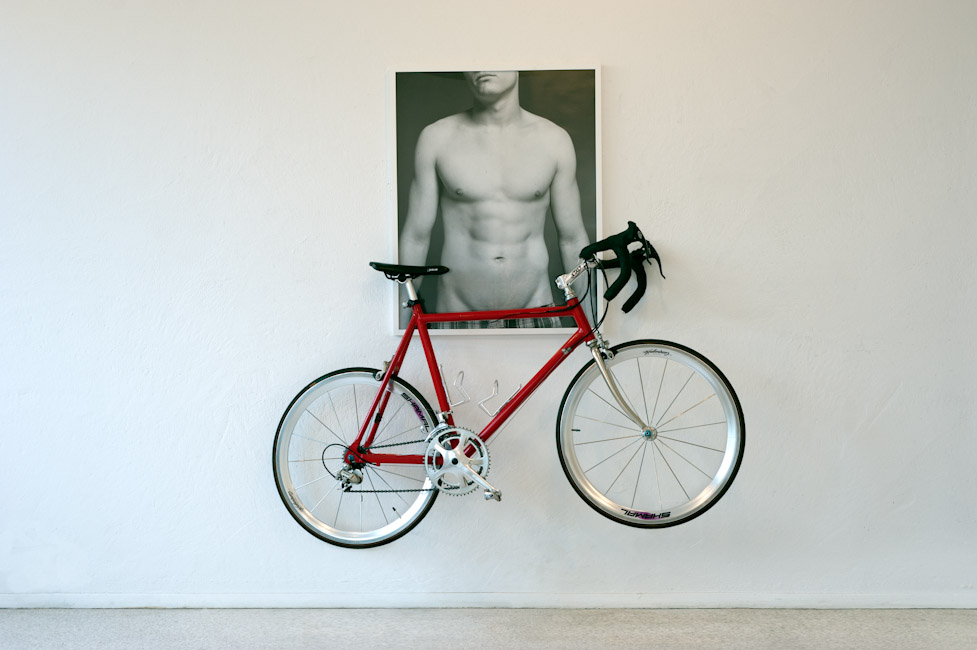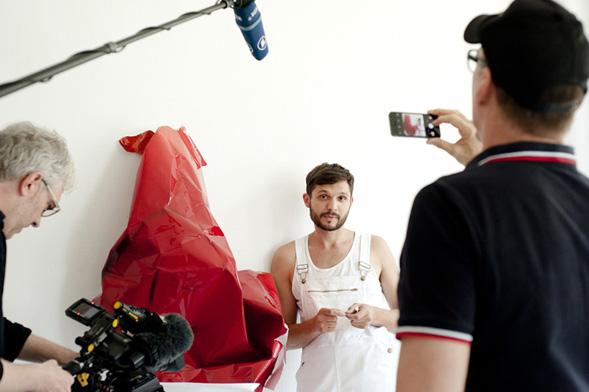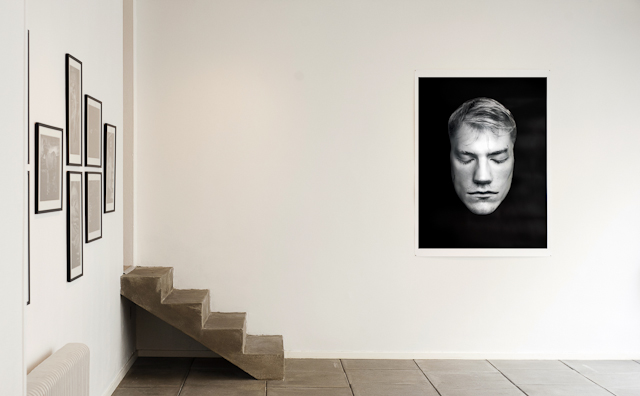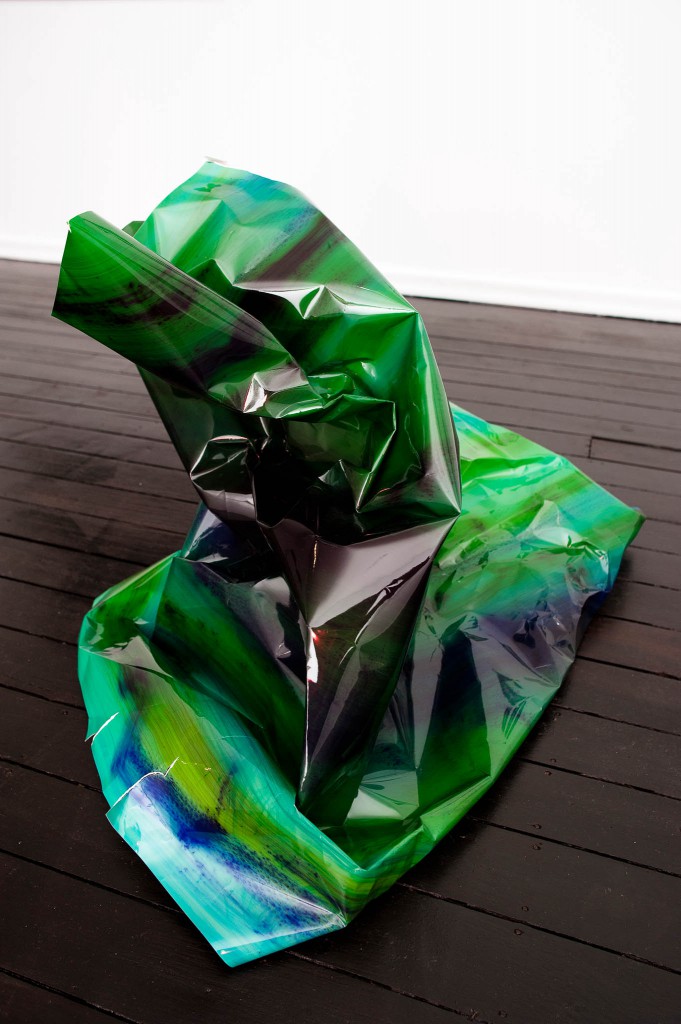Vom Verblühen und Blühen und dem Schein des Seins ≆Wither and bloom. Semblances of being.
Obergeschoss im Ross,
Heckmann Höfe,
Oranienburger Straße 32. 10117 Berlin.
Sep. – Okt. 2015
Leben und Tod. Diesseits und Jenseits. Phantasie und Wirklichkeit. Diese Kontrastpaare finden sich in Ilia Beckmanns Ausstellung „Vom Verblühen und Blühen und dem Schein des Seins“ wieder. Dafür bedient er sich der Fotografie und erweitert sie ins Skulpturale zu einem dreidimensionalen Erlebnis. Die Werke dieser Ausstellung vereint die Frage, wie die Bildkörper ihren Inhalt repräsentieren und verändern. Die fotografischen Exponate sind nicht nur starre Referenzen für Sachverhalte aus der Vergangenheit, sondern haben ein Eigenleben im Hier und Jetzt. „In der Phantasie stellt die PHOTOGRAPHIE jenen äußerst subtilen Moment dar, in dem ich eigentlich weder Subjekt noch Objekt, sondern vielmehr ein Subjekt bin, das sich Objekt werden fühlt: ich erfahre dabei im Kleinen das Ereignis des Todes: Ich werde wirklich zum Gespenst.“ (Roland Barthes, Die helle Kammer, Fft.a.M 1986)
Life and death. This world and the next. Fantasy and reality. These contrast pairs can be found in Ilia Beckmann´s exhibition „Wither and bloom. Semblances of being“. To achieve this, Ilia uses photography and expands it into threedemensional sculptural experience. These works allude to how photo content is represented and changed as a physical object. The photographic exhibits are not only rigid references of facts from the past, but also have their own life in the here and now. In terms of image-repertoire, the photograph (the one I intend) represents that very subtle moment when, to tell the truth, I am neither subjekt nor object but a subject who feels he is becoming an object: I then experience a micro-version of death: I am truely becoming a specter. (Roland Barthes, Camera Lucida, Fft.a.M. 1986).
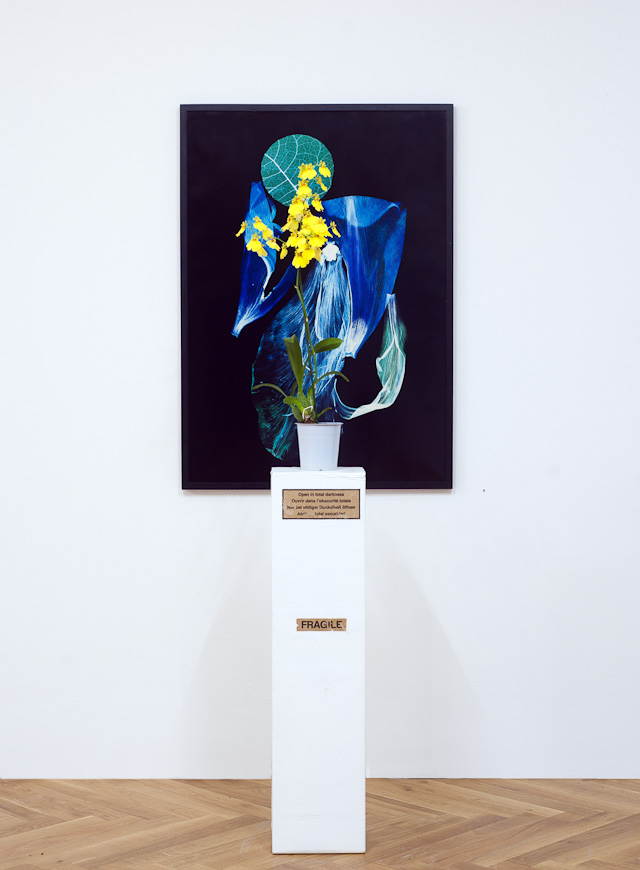
„Vom Blühen, Verblühen und Blühen“ – Serie 2015, Unikate, C-Print, Holzrahmen 70 x 100 cm, Sockel „Open only in total darkness“, Orchidee
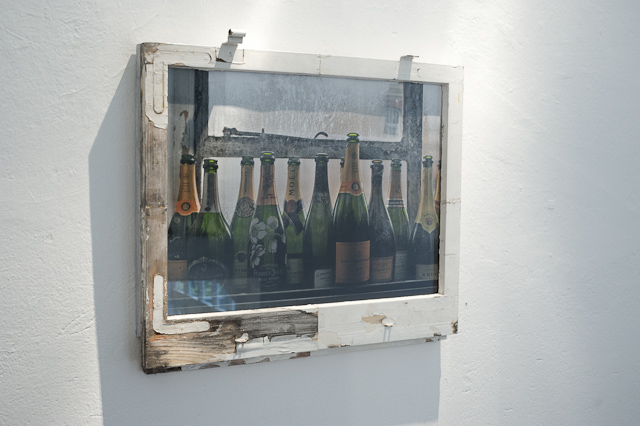
Der Schein des Seins: The bottles are always greener on the other side of the window. September 2015, Inkjet-Print 50 x 70 cm , Fensterrahmen Unikat
EIN PERFEKTER MORD Dem Akt des Fotografierens hafte etwas Räuberisches an, schrieb die amerikanische Essayistin und Regisseurin Susan Sontag einmal. „Menschen fotografieren heißt, ihnen Gewalt antun, indem man sie so sieht, wie sie selbst sich niemals sehen, indem man etwas von ihnen erfährt, was sie selbst nie erfahren; es verwandelt Menschen in Objekte, die man symbolisch besitzen kann. Wie die Kamera eine Sublimierung des Gewehrs ist, so ist das Abfotografieren eines anderen ein sublimierter Mord – ein sanfter, einem traurigen und verängstigten Zeitalter angemessener Mord.” Die Werke von Ilia Beckmann, die gerade in Berlin-Mitte zu sehen sind, könnten als Bestätigung des Aphorismus’ von Susan Sontag betrachtet werden: Der Fotograf und Bildhauer Beckmann – er legt seine Fotografien auf die Gipsgesichter der Objekte – experimentiert mit seinen Plastiken, indem er die Grenzen der üblichen Dimensionen, unsere normale Raumwahrnehmung, aufhebt. Zugleich spielt er mit der Frage, inwieweit wir einen nahen Menschen besitzen können. Seine Foto-Skulpturen sind eine Ode an die vergangene Zeit und dienen als Fossilien einer erloschenen Gegenwart, einer verblasenden Jugend. Alle in der Ausstellung versammelten, männlichen Skulpturen – mögen sie noch so einzigartig sein – teilen ein gemeinsames, kleines Detail: den Silberblick. Alle Köpfe schauen nicht geradeaus, sie würdigen dem Betrachter keines direkten Blickes. Sie blicken eher nach rechts, links oder in die Mitte. Und somit werden diese von Beckmann gefangenen Augenblicke menschlicher, rätselhafter und realer. Es muss ein witziger Mord gewesen sein. Christina Baniotopoulou für die Welt Kompakt 28. September 2015
Ausstellung in der Galleri Kirk, Denmark Aalborg, August 2014
“Schwimmende Begriffe – besetzte Schiffe” 2013, Düsseldorf K21
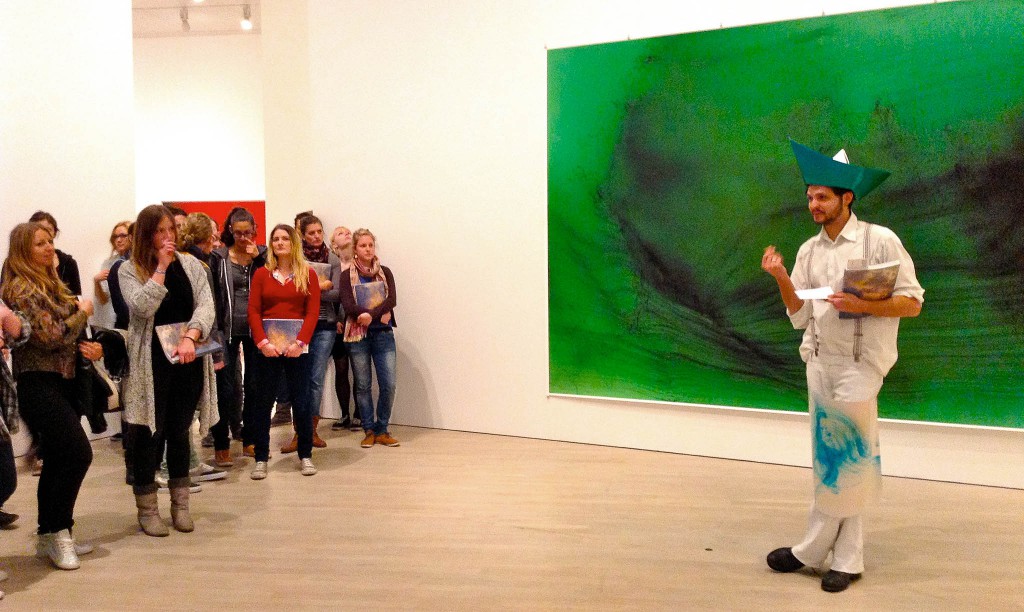
Performativer Vortrag “Schwimmende Begriffe – besetzte Schiffe”, 2013, K21 Düsseldorf, Wolfgang Tillmans Asstellung.
Woolloongabba Art Gallery Upstairs, Brisbane Australia, Dez. 2012
Photography today has become nearly ubiquitous, and it’s now such an intrinsic part of our everyday lives that it’s hard to imagine a reality without it. The work of Ilia Beckmann seeks to thoroughly examine photography in contemporary society, questioning its value while at the same time providing its own answers. Simultaneously work of technical ability and handcrafting, these diverse pieces prompt the viewer to critically analyse photography as an artistic medium. Ilia studied media publishing in Germany and attended classes in Cologne at the Institute of Art History and the Academy of Media Arts. Currently, he is studying photography at the University of Applied Science in Dortmund, travelling to Australia in June this year to complete an exchange program at Griffith University. “Photography is my biggest background, although I would say that first of all I’m an artist, then I’m a photographer, then I’m an artist again”, Ilia said. “I always think in terms of art, but I use photography as my main medium.” Ilia’s first solo exhibition entitled ‘Mens in Corpore’ was displayed in the upper floor of the Woolloongabba Art Gallery over the weekend, drawing in art enthusiasts from across Brisbane. Containing a selection of work developed over a two year period, these pieces have been produced with complicated photographic and sculptural techniques that are still in the process of being perfected and expanded upon. “It always takes time in the beginning, then you find out what you want and how it works, and you can actually produce it pretty quickly”, Ilia said. “It’s all quite different work, but I think it’s been really organic coming together. These pieces can work together, and talk to each other, although they’re still bodies of work which can exist by themselves.” Ilia’s portraits and sculptures can certainly be appreciated on a superficial level, but it’s the process behind the work and the complicated procedures involved that make the art all the more captivating. One of the most visually striking pieces in the exhibition was Ilia’s Fotoplastik series, which were essentially black and white photographs onto plaster cast faces. He applied the chemicals normally used for developing photos on paper onto the three dimensional object, which took months of experimenting and adjusting to make the plaster waterproof and chemical proof. Another piece which attracted significant attention was his tile mosaic entitled ‘Dem Bildnis ein Denkmal’. This is roughly translated to mean “A memorial for the Image”, but Ilia stressed the importance of the word ‘Denk!’, meaning to think. This piece was conceived during the artist’s studies when he was asked to produce ‘constructed photography’. Taking digital photographs of tiles and printing them skilfully with colour management onto paper, he mounted those inkjet prints onto wood in the same size of the tiles and then arranged the real and artificial pieces together. Instead of showing something constructed as being unreal or fake looking, he showed that it could look nearly identical to reality. Even though photography is central to Ilia’s work as an artist, he describes his affiliation with the medium as a love/hate relationship. At its inception, photography had a difficult struggle to become accepted as an art form, but today, this is not questioned at all. In some ways Ilia’s work is a critique of photography’s almost unchallenged artistic merit, but it also seeks to address the medium’s shortcomings in its own way. “I think my work shows what photography can be and how great photography is, but at the same time it shows how problematic it can be. Especially my Fotoplastik series, which shows that photography can be seen as the perfect combination between beautiful and terrible, and between very alive and very dead,” Ilia continued, “The dominant theme is that the medium is the message. I encountered problems with this medium, and I wanted to give solutions. I just want people to be a little more critical about photography, and try find out the actual purpose for making pictures is, what you can learn, and what’s good about it.” As for his next artistic endeavours, Ilia will continue to refine his techniques and work towards more exhibitions in the near future. Finding himself often exhausted when working with the same subject matter, he strives to push himself in new and interesting directions. His immediate plans are to continue developing the processes demonstrated by his Fotoplastik series, and introducing colour pigment into its already intricate procedure. He would also like to expand upon his work with backdrops, an idea which occupied only a small part of his latest exhibition. “Unfortunately this exhibition was just for four days, but I came to Australia hardly knowing anybody, and I’m really happy that I was able to achieve so much, and I’m really glad and grateful to have had this opportunity,” Ilia said. “I’m full of ideas, and I’m really interested in experiencing something right here and now in the space-time continuum with other people together, creating really emotional spaces”. “I try to avoid making my work too reproducible. Because of the many steps involved, the more mistakes I can make, and mistakes are actually a great source of new and interesting things. I just hope that younger people who grow up in times where the computer is such a normal thing, that they still learn to do things with their bodies, to do something with more soul.” By Sam Banks on December 10, 2012 http://giftedandtalented.net.au/art/ilia-beckmann-in-focus/
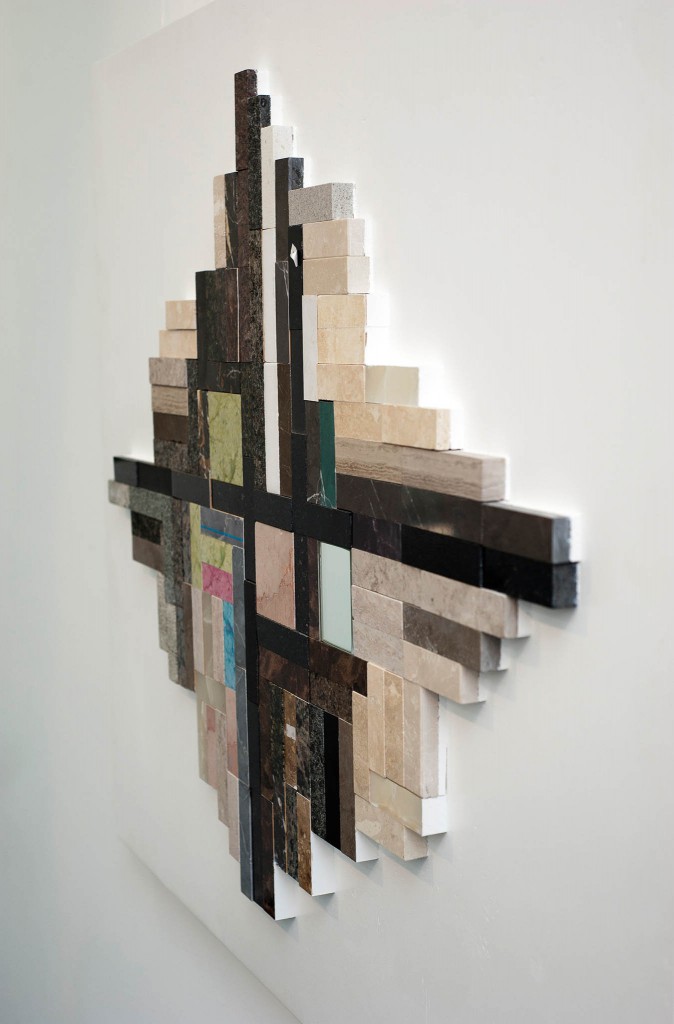
“Dem Bildnis ein Denkmal”, 120 x 100 cm, 2012. Gesteine, Fotografien, Spiegel und Preisschild auf lackiertem Holz. Woolloongabba Art Gallery, Brisbane, Australia, Dez. 2012
In „Dem Bildnis ein Denkmal“ Beckmann provides an interplay between ‘the real’ and the crafted. Splicing photographs of tiles with fragments of the real stone tiles, Beckmann creates a collage of real and photographically reproduced surfaces that exist in complete harmony, yet are conceived by inherently different processes. While the stone may have taken years to form, its aesthetically esteemed surface can be reproduced as a virtually identical image in a matter of seconds. Yet, as swiftly as they are formed, the photographs can deteriorate. Another element of this work is a mirror. Inside the collage of both real and replicated surfaces the viewer is confronted with a replication of their own physical appearance. This duality of identical ‘real’ and replicated elements questions the values of material embodiment by highlighting aesthetic similarities. By Tara Heffernan, Art Theorist
